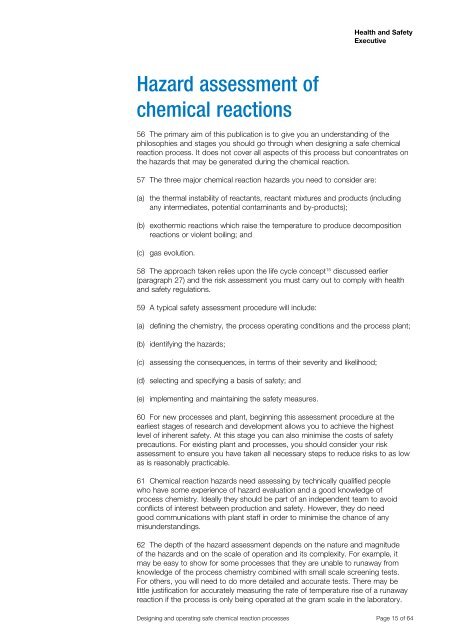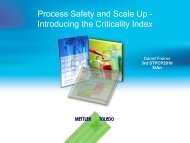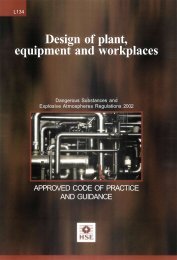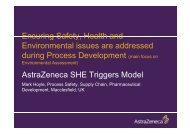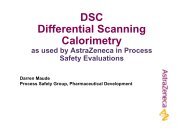Designing and operating safe chemical reaction processes HSG143
Designing and operating safe chemical reaction processes HSG143
Designing and operating safe chemical reaction processes HSG143
You also want an ePaper? Increase the reach of your titles
YUMPU automatically turns print PDFs into web optimized ePapers that Google loves.
Health <strong>and</strong> SafetyExecutiveHazard assessment of<strong>chemical</strong> <strong>reaction</strong>s56 The primary aim of this publication is to give you an underst<strong>and</strong>ing of thephilosophies <strong>and</strong> stages you should go through when designing a <strong>safe</strong> <strong>chemical</strong><strong>reaction</strong> process. It does not cover all aspects of this process but concentrates onthe hazards that may be generated during the <strong>chemical</strong> <strong>reaction</strong>.57 The three major <strong>chemical</strong> <strong>reaction</strong> hazards you need to consider are:(a) the thermal instability of reactants, reactant mixtures <strong>and</strong> products (includingany intermediates, potential contaminants <strong>and</strong> by-products);(b) exothermic <strong>reaction</strong>s which raise the temperature to produce decomposition<strong>reaction</strong>s or violent boiling; <strong>and</strong>(c) gas evolution.58 The approach taken relies upon the life cycle concept 15 discussed earlier(paragraph 27) <strong>and</strong> the risk assessment you must carry out to comply with health<strong>and</strong> <strong>safe</strong>ty regulations.59 A typical <strong>safe</strong>ty assessment procedure will include:(a) defining the chemistry, the process <strong>operating</strong> conditions <strong>and</strong> the process plant;(b) identifying the hazards;(c) assessing the consequences, in terms of their severity <strong>and</strong> likelihood;(d) selecting <strong>and</strong> specifying a basis of <strong>safe</strong>ty; <strong>and</strong>(e) implementing <strong>and</strong> maintaining the <strong>safe</strong>ty measures.60 For new <strong>processes</strong> <strong>and</strong> plant, beginning this assessment procedure at theearliest stages of research <strong>and</strong> development allows you to achieve the highestlevel of inherent <strong>safe</strong>ty. At this stage you can also minimise the costs of <strong>safe</strong>typrecautions. For existing plant <strong>and</strong> <strong>processes</strong>, you should consider your riskassessment to ensure you have taken all necessary steps to reduce risks to as lowas is reasonably practicable.61 Chemical <strong>reaction</strong> hazards need assessing by technically qualified peoplewho have some experience of hazard evaluation <strong>and</strong> a good knowledge ofprocess chemistry. Ideally they should be part of an independent team to avoidconflicts of interest between production <strong>and</strong> <strong>safe</strong>ty. However, they do needgood communications with plant staff in order to minimise the chance of anymisunderst<strong>and</strong>ings.62 The depth of the hazard assessment depends on the nature <strong>and</strong> magnitudeof the hazards <strong>and</strong> on the scale of operation <strong>and</strong> its complexity. For example, itmay be easy to show for some <strong>processes</strong> that they are unable to runaway fromknowledge of the process chemistry combined with small scale screening tests.For others, you will need to do more detailed <strong>and</strong> accurate tests. There may belittle justification for accurately measuring the rate of temperature rise of a runaway<strong>reaction</strong> if the process is only being operated at the gram scale in the laboratory.<strong>Designing</strong> <strong>and</strong> <strong>operating</strong> <strong>safe</strong> <strong>chemical</strong> <strong>reaction</strong> <strong>processes</strong> Page 15 of 64


